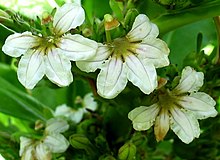Scaevola taccada
| Scaevola taccada | |
|---|---|
 |
|
| Scaevola taccada in its typical habitat; Maui, Kanaha Beach | |
 |
|
| S. taccada flower | |
| Scientific classification | |
| Kingdom: | Plantae |
| (unranked): | Angiosperms |
| (unranked): | Eudicots |
| (unranked): | Asterids |
| Order: | Asterales |
| Family: | Goodeniaceae |
| Genus: | Scaevola |
| Species: | S. taccada |
| Binomial name | |
|
Scaevola taccada (Gaertn.) Roxb. |
|
| Synonyms | |
|
|
Scaevola taccada, also known as beach cabbage, sea lettuce, beach naupaka, naupaka kahakai (Hawaiian), magoo (Divehi), merambong (Malay) and ngahu (Tongan) is a flowering plant in the family Goodeniaceae found in coastal locations in the tropical areas of the Indo-Pacific. It is a common beach shrub throughout the Arabian Sea, the tropical Indian Ocean and the tropical Islands of the Pacific.
It is a large bush reaching up to about 4 m in height typical of littoral zones where it grows very close to the sea exposed to the salt spray, usually on sandy or pebbly soils. Leaves are slightly succulent, about 20 cm long, closely alternate and crowded at the stem tips. They are glabrous with a fleshy-looking yellowish green color. The fruits and flowers are white. Scaevola taccada blooms the whole year round and the flowers have a fan-like shape which gives them the name fanflower or half flower. The fruits float in seawater and are propagated by ocean currents, this bush being one of the pioneer plants in new sandbanks in tropical areas.
The coastal areas and beaches of Okinawa, Taiwan, Southern China, Vietnam, Malaysia, Philippines, Indonesia, East Timor, Northern Australia, Polynesia, Melanesia, Micronesia, East Africa, Madagascar, Mauritius, Seychelles, Oman, Yemen, India, Maldives, Burma, Thailand, Cambodia, Chagos Islands, Comoros, Réunion.
...
Wikipedia
